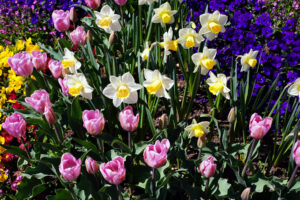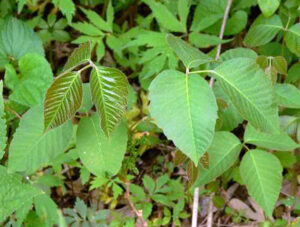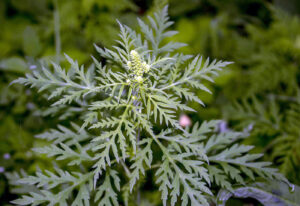By Erika Segerson-Mueller, DNR Invasive Plant Program Specialist, Oshkosh;
Erika.SegersonMueller@wisconsin.gov or 715-492-0391

While not native to the Midwest, popular garden plants such as tulips and daffodils do not spread outside of gardens or cause harm, therefore they are not invasive. / Photo Credit: Lesley Ingram, Bugwood.org
As the conversation around invasive plants grows, it’s easy to get “stuck in the weeds” when it comes to invasive terminology.
A simple Google search of “invasive plant” will produce a variety of definitions, bringing in technicalities or muddying your understanding with each new idea of what invasive means.
How Is ‘Invasive’ Defined?
To cut through the confusion, look to the federal government’s definition, established by Executive Order 13112 in 1999. It defines an invasive species as “an alien species whose introduction does or is likely to cause economic or environmental harm or harm to human health.”
Under Wisconsin Statute Section 23.22 (1) (c), this definition is reworded slightly to read “nonindigenous species whose introduction causes or is likely to cause economic or environmental harm or harm to human health.”
To break this down further, to be classified as an invasive plant, a species a) must not have originated in the location being discussed and b) must cause or show high probability to cause harm financially, to habitats within the location or to health of humans who encounter it.
Are All Non-native Plants Invasive?

Though poison ivy may cause skin irritation, the plant is native to Wisconsin and therefore is not regulated as invasive species. / Photo Credit: Christopher Noll, Flora of Wisconsin, wisflora.herbarium.wisc.edu
Just because a plant is not native to an area does not mean it will become invasive. Many non-native plants do not spread aggressively when introduced to new areas, and many do not cause harm to the economy, environment or human health.
Some examples are tulips, daffodils, petunias and peonies. These popular garden plants and many other iconic flowers are not native to the Midwest but do not become invasive.
What About Native Plants?
Under EO 13112, native species are defined as “with respect to a particular ecosystem, a species that, other than as a result of an introduction, historically occurred or currently occurs in that ecosystem.”
By definition, invasive plants were introduced by humans either intentionally or unintentionally and thus are not native to the location in question. Therefore, native plants cannot be called invasive when found in their native habitat.
Some native plants are known as “nuisance” or “aggressive natives.” Poison ivy (Toxicodendron radicans) and common ragweed (Ambrosia artemisiifolia) are both examples of native nuisance plants. Both plants can negatively affect human health, but since they are native to Wisconsin, they are not invasive. As native plants do not qualify as true invasives, they are not regulated under invasive species rules.

The pollen of common ragweed can cause allergy symptoms. The plant is native to Wisconsin and, as such, is not regulated as an invasive species. / Photo Credit: Aaron Carlson, Flora of Wisconsin, wisflora.herbarium.wisc.edu
How Are Invasives Regulated In Wisconsin?
Wisconsin has an Invasive Species Identification, Classification, and Control Rule known as NR40. This rule uses specific terminology to divide invasive species into categories, with two used most frequently: prohibited and restricted.
Prohibited invasive species are those that are not yet in Wisconsin or that have only been found in a few locations. These species are likely to cause environmental and/or economic harm. Because they haven’t been established yet, eradicating or preventing these species is feasible.
Wisconsin residents cannot transport, possess, transfer, or introduce prohibited species without a permit. If located, control of these species is required.

Kudzu is not yet found in Wisconsin, but is a prohibited species because of its likelihood to cause harm to trees and shrubs. / Photo Credit: Amy Ferriter, State of Idaho, Bugwood.org
Kudzu (Pueraria montana) is a prohibited plant species in Wisconsin. Known as “the vine that ate the South,” this plant has not yet been found in the state but would likely cause significant environmental harm in woodlands. Kudzu can grow a foot in length each day and can girdle or blanket trees and shrubs, adding substantial weight and increasing the likelihood they will be pulled down.
Restricted invasive species are already widely established in the state, and there is evidence of high environmental and/or economic impacts from these species. Because they are established, complete eradication is unlikely, but control efforts are encouraged.
Wisconsin residents cannot transport, transfer or introduce restricted species without a permit. Possession of these species is allowed but discouraged due to the potential for further invasion.
Common buckthorn (Rhamnus cathartica) is a well-known restricted invasive plant species. If found in your woods, control is recommended to avoid further spread.

Though common buckthorn may be a common sight in the woods, the species is restricted under NR40, and control work is recommended. / Photo Credit: Wisconsin DNR
Whether invasive species or aggressive native plants, a few simple actions will help slow the spread of weeds throughout your woods.
- Clean off pets, boots and equipment when moving from location to location. Seeds and plant debris can easily hitch a ride in the tread of shoes, tires or pet fur on clothing, so check yourself thoroughly and brush off any plant material you find.
- If you recreate on wheels, such as by bicycle or ATV, or use heavy equipment when working in the woods, clean your rig before and after visiting trails or logging roads.
- Learn to identify what’s in your woods. Brush up on regulated invasive plants in Wisconsin by visiting the DNR’s Regulated Species webpage.
